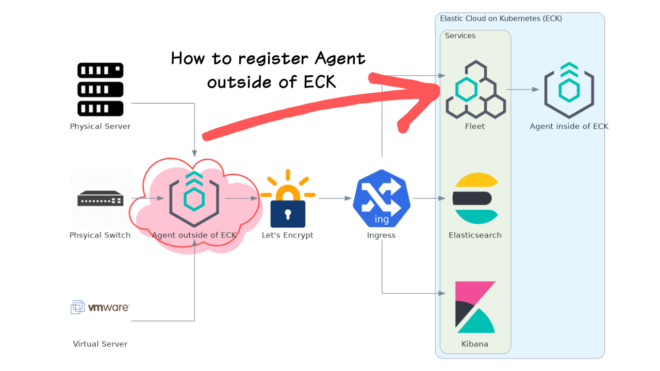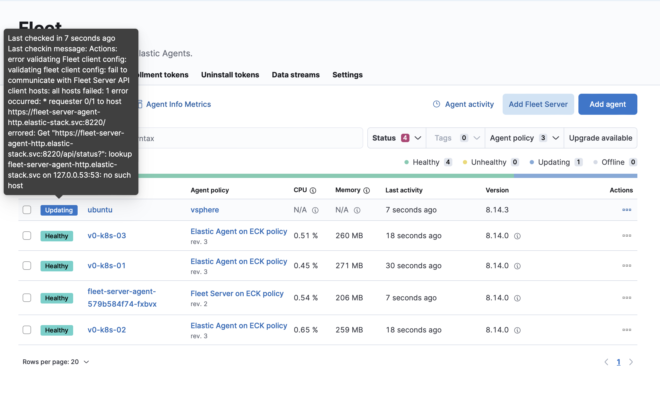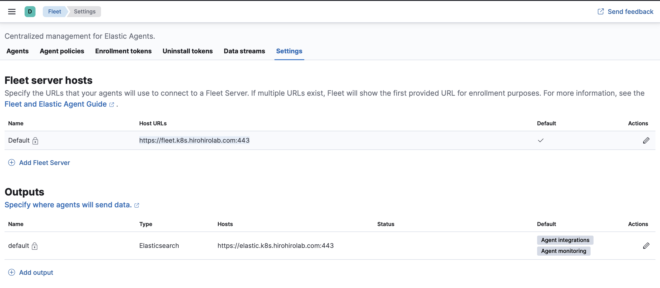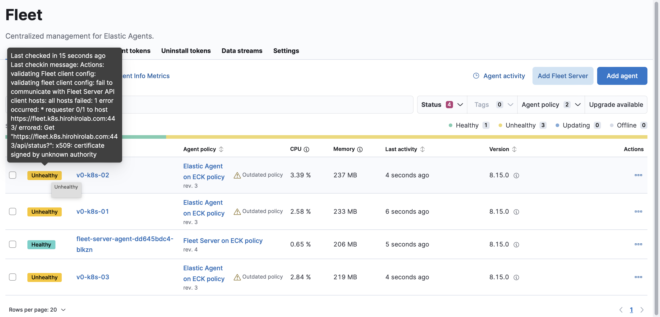Introduction #
When using Elastic Cloud on Kubernetes (ECK), there may be times when you want to collect logs from physical devices or VMs outside of ECK.

In this case, since the agents inside ECK are not exposed externally, you need to set up agents outside of ECK and register them with Fleet. However, this process can be quite challenging and there are various issues.
- Issues related to certificate problems when registering agents outside of ECK, with no documentation leading to confusion:
- Issues where agents become unhealthy when FleetServer is exposed via Ingress:
- Issues mentioning the causes of agents becoming unhealthy when FleetServer is exposed via Ingress:
This post will introduce these issues and their solutions.
1. The Problem #
The reason why external Elastic Agents cannot register with the ECK fleet-server is fully documented in the following issue:
https://github.com/elastic/elastic-agent/issues/2762
2. Solutions #
We will briefly touch on the causes and introduce the solutions.
1. Expose fleet-server externally via Ingress
To allow external agents to access the ECK fleet-server, you need to expose the fleet externally by some means. As mentioned in ECK in production environment, it is recommended to expose ECK with TLS, so using Ingress to expose ElasticSearch, Kibana, and Fleet is common.
Here is a sample of the Ingress configuration I used.
# SAMPLE (nginx ingress controller + cert-manager + let's encrypt)
---
apiVersion: networking.k8s.io/v1
kind: Ingress
metadata:
name: kibana-ingress
namespace: elastic-stack
annotations:
cert-manager.io/cluster-issuer: "letsencrypt-prod"
ingress.kubernetes.io/force-ssl-redirect: "true"
nginx.ingress.kubernetes.io/backend-protocol: HTTPS
nginx.ingress.kubernetes.io/proxy-connect-timeout: "3600"
nginx.ingress.kubernetes.io/proxy-read-timeout: "3600"
nginx.ingress.kubernetes.io/proxy-send-timeout: "3600"
spec:
ingressClassName: nginx
tls:
- hosts:
- "*.k8s.hirohirolab.com"
secretName: quickstart-example-tls # https://cert-manager.io/docs/tutorials/acme/nginx-ingress/
rules:
- host: elastic.k8s.hirohirolab.com
http:
paths:
- path: /
pathType: Prefix
backend:
service:
name: elasticsearch-es-http
port:
number: 9200
- host: kibana.k8s.hirohirolab.com
http:
paths:
- path: /
pathType: Prefix
backend:
service:
name: kibana-kb-http
port:
number: 5601
- host: fleet.k8s.hirohirolab.com
http:
paths:
- path: /
pathType: Prefix
backend:
service:
name: fleet-server-agent-http
port:
number: 8220
- path: /) for Ingress routing, it seems to result in 404 Not Found due to redirects. Github-issue: Document edge cases around Fleet/Agent setups with Ingress
2. Change Fleet communication to go through Ingress
Although Fleet is now exposed via Ingress, the default setting accesses it via Servicehttps://elasticsearch-es-http.elastic-stack.svc:9200, making it inaccessible to external agents.

Therefore, we need to change the fleet-server communication to go through Ingress.
- before
# https://github.com/elastic/cloud-on-k8s/blob/c25ae520dbba3d83231b96fb9e10dc081546ff39/deploy/eck-stack/examples/agent/fleet-agents.yaml#L40
xpack.fleet.agents.elasticsearch.hosts: ["https://elasticsearch-es-http.elastic-stack.svc:9200"]
xpack.fleet.agents.fleet_server.hosts: ["https://fleet-server-agent-http.elastic-stack.svc:8220"]
- after
# THIS IS A SAMPLE. INPUT YOUR FLEET AND ELASTIC URL.
xpack.fleet.agents.elasticsearch.hosts: ["https://elastic.k8s.hirohirolab.com"]
xpack.fleet.agents.fleet_server.hosts: ["https://fleet.k8s.hirohirolab.com"]
This will switch Fleet communication to go through Ingress.

3. Certificate management for agents (problem)
This allows external agents to register, but now internal agents will encounter certificate errors as shown below.

The cause is that internal agents store a self-signed certificate generated by ECK in FLEET_CA.
root@v0-dev-03:~/project/kubernetes-ingress# kubectl exec -it eck-stack-with-fleet-eck-agent-agent-84thl -n elastic-stack -- /bin/bash
root@v0-k8s-03:/usr/share/elastic-agent# export | grep CA
declare -x FLEET_CA="/mnt/elastic-internal/fleetserver-association/elastic-stack/fleet-server/certs/ca.crt" # Insert By elastic-operator
Since we changed the fleet-server access to go through Ingress, it now uses the certificate registered with Ingress instead of the FLEET_CA certificate. As a result, certificate verification fails and an error occurs.
4 OverrideFLEET_CAandFLEET_URL
To resolve this, you can override FLEET_CA="" to use a general certificate (such as one from Let’s Encrypt or another external CA). Refer to the official documentation. Additionally, FLEET_URL needs to be changed to the Ingress URL.
root@v0-k8s-03:/usr/share/elastic-agent# export | grep FLEET_URL
declare -x FLEET_URL="https://fleet-server-agent-http.elastic-stack.svc:8220"
These environment variables are set by the elastic-operator, but according to the official documentation, they can be overridden.
In the official Helm chart, you add them under the daemonSet section.
# https://github.com/elastic/cloud-on-k8s/blob/c25ae520dbba3d83231b96fb9e10dc081546ff39/deploy/eck-stack/examples/agent/fleet-agents.yaml#L98
daemonSet:
podTemplate:
spec:
serviceAccountName: elastic-agent
hostNetwork: true
dnsPolicy: ClusterFirstWithHostNet
automountServiceAccountToken: true
securityContext:
runAsUser: 0
# OVERRIDE ENV VARS
containers:
- name: agent
env:
- name: FLEET_CA
value: ""
- name: FLEET_URL
value: "https://fleet.k8s.hirohirolab.com" # THIS IS A SAMPLE. INPUT YOUR FLEET URL.
5. Completion
Deploying with these settings will override the environment variables, and the status will become HEALTHY.
root@v0-dev-01:~/project/elasticsearch/cloud-on-k8s# kubectl exec -it eck-stack-with-fleet-eck-agent-agent-84thl -n elastic-stack -- /bin/bash
root@v0-k8s-01:/usr/share/elastic-agent# export | grep -E "FLEET_CA|FLEET_URL"
declare -x FLEET_CA=""
declare -x FLEET_URL="https://fleet.k8s.hirohirolab.com"
root@v0-k8s-01:/usr/share/elastic-agent# elastic-agent status
┌─ fleet
│ └─ status: (HEALTHY) Connected
└─ elastic-agent
└─ status: (HEALTHY) Running

Conclusion #
Conclusion With this setup, both external and internal agents can connect to the fleet-server via Ingress.
If TLS communication is not necessary or setting up Ingress is difficult, you can expose the fleet-server using LoadBalancer or NodePort and override with FLEET_INSECURE=1 to resolve the issue (untested).
Appendix #
If you want to collect logs outside of ECK using Beats/Logstash instead of Elastic Agent, it’s simple. The official Helm chart already provides an example where Beats is exposed externally.
# https://github.com/elastic/cloud-on-k8s/blob/c25ae520dbba3d83231b96fb9e10dc081546ff39/deploy/eck-stack/examples/logstash/basic-eck.yaml#L105C1-L114C31
services:
- name: beats
service:
spec:
type: ClusterIP
ports:
- port: 5044
name: "filebeat"
protocol: TCP
targetPort: 5044
Additionally, there is a guide on how to forward Syslog from Pure Storage (physical storage) to ECK. link

